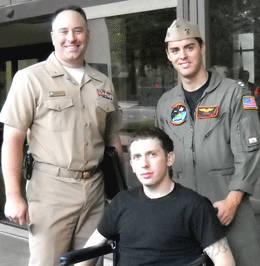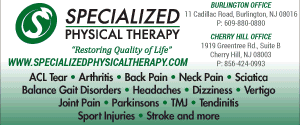
A cutting-edge medical procedure helps a wounded soldier get back on his feet.
Edward and Kathy Bonfiglio had anticipated they’d receive a call from their son, Ed Bonfiglio, in the early morning hours. A Navy Corpsman, the now 28-year-old was stationed in Afghanistan at the time, serving as a medic for the Marines. But when the phone rang at 5 a.m. on Aug. 10, 2009, in their Runnemede home, the conversation did not go as planned.
“We hadn’t heard from him for about a month,” recalls Kathy. “Because the phone was ringing at 5 a.m., we figured it was probably him calling; you never know what time you’re going to hear from him. We just figured it was a routine call we’d get. “But when his dad picked up the phone, all I heard him say was, ‘Don’t tell mom, but I’ve been shot,’” she continues. “Of course I overheard it, and I said, ‘Just give me the phone.’”
Kathy would learn Ed had received a gunshot wound through his upper left thigh; ambushed while on foot patrol. The wound would leave Ed and his family with a tough decision to make—to amputate or not to amputate his leg—but an innovative doctor, and an innovative new product by AxoGen, a young company providing nerve repair solutions, would allow him to keep his leg and help change the outcome of those like him in the future.
Finding a solution
The weeks after Ed was injured proved difficult for the family, as he was moved around to several medical facilities overseas and his family rarely knew where he was. “We kind of lost him for a while,” Kathy says. “We contacted the Marines and the Marines said they were going to turn him back over to the Navy, and when we contacted the Navy, the Navy didn’t know where he was.”
Eventually Ed was flown to Walter Reed National Military Medical Center in Bethesda, Md. If you did not see the bullet hole in his leg, it appeared uninjured—the bullet had hit no bone or major arteries—but he had lost five centimeters of his sciatic nerve. “The one thing I remember his parents telling me is that the doctors there were quite surprised that he was still able to bend his leg at his knee,” recalls Tom Bonfiglio, Ed’s uncle, “but he couldn’t move his toes or ankle.”
Ed remembers discussing his options with his doctor, Dr. Patrick Basile, while lying in a hospital bed at Walter Reed. “The first option was amputation,” he says. “He also said we could try a commercially available nerve graft and see how my body accepted it and how well I did with it. I figured I could always amputate my leg. Once it was amputated, I couldn’t try this procedure.”
Ed’s injury would be repaired using a product called Avance Nerve Graft. What makes AxoGen’s product unique is that it is human nerve tissue, recovered from deceased donors, that has been specially processed to remove cellular components but maintain the architecture that allows the body to regenerate the nerve. In some cases, a patient’s own nerves can be used from another part of his or her body, but Ed’s situation did not allow for that.
“Traditionally, to treat a nerve injury where nerve tissue is missing, the surgeon replaced the injured nerve with healthy nerve tissue from somewhere else in the patient’s body—frequently a nerve from the lower leg. However, that approach, called nerve autograft, requires a second surgical site and can leave the patient with lifelong numbness or pain at the site of the removal,” explains Jill Schiaparelli, senior vice president, business strategy and marketing for AxoGen. “However, Ed’s surgeon knew that the likelihood of being able to harvest enough nerve from elsewhere in Ed’s body and have a successful outcome was very low and that drove the doctor and Ed’s family to explore other options.”
Fortunately, Dr. Basile had heard about AxoGen’s nerve graft product, which was still relatively new to the market when Ed was injured in 2009, and thought Ed would be a good candidate for this innovative technology. The other unique part about Ed’s case, however, was that this type of nerve grafting had not yet been done on the scale necessary to help him. Fortunately, Dr. Basile was able to bundle three Avance Nerve Graft segments together to make up the diameter necessary to fix Ed’s nerve.
It took some time for Ed to see progress after the two-hour surgery, but he did eventually regain movement in his leg. “It was about six to eight months before I actually saw movement and was able to walk without crutches,” he says. Today, he still has not regained 100 percent use of his leg, but he is happy to have been given the opportunity to walk again on his own two feet.
Looking to the future
Ed joined the Navy right out of high school. It was something he always wanted to do, and it would help him gain the medical background he was looking for while also serving his country. “It also offered benefits for college,” he notes. Ed’s father and brother have also served in the Armed Forces.
After spending time recovering from his injury, Ed started taking classes at East Carolina University. Max, a fellow serviceman Ed had met in Bethesda who had his leg amputated, was attending Penn State at the same time, and helped convince Ed to transfer to the school. Now Ed is studying to become a physician’s assistant while also training with Max to compete in the Paralympics.
“I’m trying to get to Rio for the 2016 Paralympics for distance and javelin,” Ed says. “I’m trying to get on the level to be a part of that. That’s my goal.”
As Ed has grown, so has AxoGen. Since 2009, the company has aided thousands of patients with peripheral nerve injuries and developed clinical data. The company is now publicly traded on the NASDAQ stock exchange and had revenues of nearly $11 million last year. Schiaparelli says the company has followed Ed’s case, and they are thrilled with how far he has come.
“Over 1.4 million people in the United States experience a peripheral nerve injury each year. It could be a common household injury such as a finger laceration, a DIY or workplace injury from a power tool or even an injury to the nerve from a surgical procedure. AxoGen is entirely focused on helping patients with peripheral nerve injuries, whatever the cause,” she says. “Ed has truly become AxoGen’s inspiration.
Knowing the profound impact that our nerve repair technology had on his life makes us driven to promote awareness among surgeons and patients that there have been important advancements in nerve surgery and that they have options when it comes to peripheral nerve repair.”
In fact, Ed’s story was so moving that when the American Association of Tissue Banks looked to nominate a tissue transplant recipient as a rider on the Donate Life Float in the 2014 Tournament of Roses Parade, they selected Ed to represent the important role of tissue donation in helping patients with nerve injuries.
“The AATB seeks to promote awareness of the important role that the tissue donation process plays in helping living recipients,” Schiaparelli explains. “When they learned of the profound impact that Avance Nerve Graft—the first commercially available processed human nerve tissue product—had in helping restore quality of life to Ed after he valiantly served our country, they thought it an ideal opportunity to tell the story of how this and other donated tissues truly impact people and to encourage people to consider making the ‘gift of life.’”
Ed says participating in the parade was an opportunity to help raise awareness that amputation doesn’t always have to be the answer when it comes to injuries like his. “It just lets people know that there’s another option, instead of automatically going straight to amputation. There are people out there trying to help and donate when they can. … There’s nothing wrong with amputation. In the back of my mind I still go through the idea of it. But there are options.”
Despite everything he’s gone through, Ed’s family is optimistic for his future and they are thankful for everything he has been given. “He came through a tough road and we’re proud of him,” Tom says. “There’s something bigger in this than any of us can imagine. He’s a pioneer. He’s the first guy to have this type of repair with Avance Nerve Graft. I think there’s a calling for him. This particular operation/procedure is hope for not only military but non-military as well who are facing the same thing. He’s a beacon of hope to other people.”
Published (and copyrighted) in South Jersey Magazine, Volume 11, Issue 4 July, 2014).
For more info on South Jersey Magazine, click here.
To subscribe to South Jersey Magazine, click here.
To advertise in South Jersey Magazine, click here.












